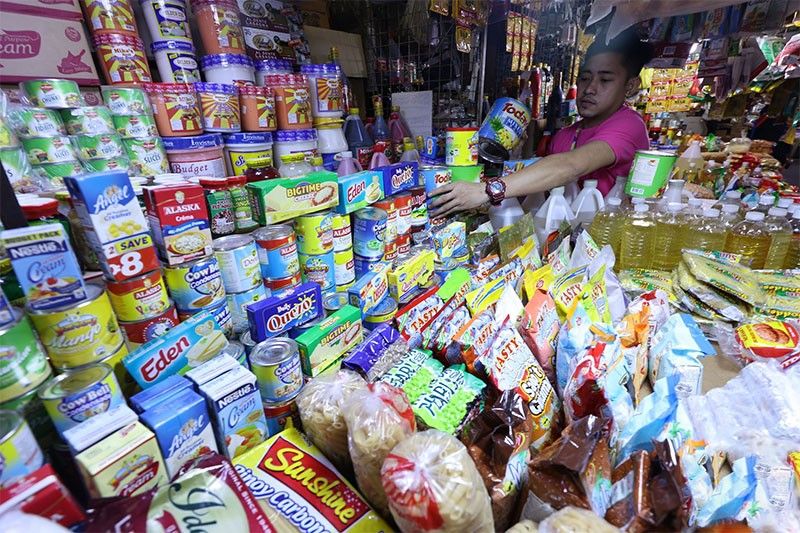Inflation eases to 22-month-low 3.9 percent in December

MANILA, Philippines — The country’s inflation rate eased further in December to its lowest level in nearly two years, driven by the slower increase in utility costs and food prices, according to the Philippine Statistics Authority (PSA).
At a press conference yesterday, National Statistician Dennis Mapa said headline inflation or the rate of increase in the average prices of goods and services typically purchased by consumers slowed down further to 3.9 percent in December from 4.1 percent in November, and 8.1 percent in December 2022.
“This was the slowest since February of 2022 when the headline inflation was recorded at three percent,” he said.
The December inflation print, which decelerated for the third straight month, is within the Bangko Sentral ng Pilipinas’ 3.6 to 4.4 percent forecast for that month and marks the return to the central bank’s two to four percent target range.
Average inflation for 2023 was at six percent, higher than the 5.8 percent in 2022.
Mapa cited housing, water, electricity, gas and other fuels as the main driver of the downward trend in inflation as the commodity group registered a lower growth of 1.5 percent in December from 2.5 percent in the previous month.
Food and non-alcoholic beverages also had a slower inflation rate of 5.4 percent in December from 5.7 percent in November.
Inflation for food alone eased to 5.5 percent in December from the previous month’s 5.8 percent due to the faster declines in prices of vegetables and oils and fats, as well as slower increase in meat prices.
Rice inflation, however, rose further to 19.6 percent in December from November’s 15.8 percent.
Mapa said the December rice inflation is the highest since March 2009, when it hit 22.9 percent. He said the average prices of the three varieties of rice tracked by the PSA went up in December from the previous month.
As rice inflation registered a higher rate in December, National Economic and Development Authority Secretary Arsenio Balisacan underscored the importance of Executive Order 50, which extended the Most Favored Nation reduced tariff rates for key agricultural commodities like pork, corn and rice to ensure sufficient food supply and keep prices affordable.
“Amid an uptrend in international rice prices and the expected negative impact of the El Niño phenomenon, the Interagency Committee on Inflation and Market Outlook will closely monitor the situation and propose further temporary tariff adjustments if necessary. We will also push for trade facilitation measures to reduce other non-tariff barriers,” he said.
While the medium-term objective is to boost agricultural productivity, he said it is necessary to augment domestic supply to ease inflationary pressures, particularly to low-income households.
Wholesale price index
Wholesale prices of goods at the national level picked up at a slower pace in November from the previous month due largely to a decline in fuel prices, according to the PSA.
Data from the PSA yesterday showed the growth of the General Wholesale Price Index (GWPI) in the country eased to 4.2 percent in November last year from 4.4 percent in October 2023.
The GWPI growth in November last year is also lower than the 7.2 percent uptick in the same month of 2022.
“The annual rate of mineral fuels, lubricants and related materials decreased further to 6.7 percent in November 2023 from a 3.7 percent drop in October 2023, which primarily caused the downtrend in the annual rate of the GWPI in the country,” the PSA said.
In addition, four commodity groups posted slower increases in November from the previous month such as food at 6.8 percent from seven percent – chemicals including animal and vegetable oils and fats at 1.5 percent from 1.8 percent; machinery and transport equipment at 1.3 percent from 1.5 percent and miscellaneous manufactured articles at 3.3 percent from 3.6 percent.
In Luzon, the GWPI growth also slowed down to 4.1 percent in November 2023 from the 4.4 percent increase in October 2023, and 7.4 percent uptick in November 2022.
The Visayas also registered slower GWPI growth of 5.2 percent in November from 5.3 percent in October 2023, and 6.5 percent in November 2022.
As for Mindanao, the GWPI growth increased further to 3.6 percent in November 2023 from 3.3 percent in October 2023. Mindanao’s GWPI growth in November, however, is lower than the 4.8 percent increase in the same month in 2022.
Food production
The government will further boost food production and implement measures to keep the prices of basic commodities affordable, President Marcos assured the public on Friday as the 2023 inflation rate settled to its lowest level in December. “The government continues to work hard to improve the condition of our economy. For the new year, we will further strengthen programs for agriculture and focus on measures to keep the price of food and other basic commodities affordable,” the President said in Filipino in his official X account.
Inflation
The decline in inflation to below the BSP target range of 2-4 percent by the end of 2023 was expected, House committee on ways and means chair Joey Salceda said yesterday.
In a statement, Salceda noted that this figure is aligned with his office’s estimates. The same goes for the annual average inflation of 6.0 percent.
“As I emphasized last month, the government must zero-in its efforts on rice, which has accelerated its inflation to 19.6 percent. All other commodity prices are under control,” he added.
The Albay representative cited, for instance, that the 12.2 percent inflation rate for fruits and nuts can be attributed to seasonal consumption during the Christmas season.
He underscored that the price increase on water supply, subject to regulation, is needed. On the other hand, all other commodity prices are either in single-digit or negative inflation. Corn inflation, in particular is negative, and this has resulted in a mere 0.2 percent inflation for meat.
Salceda underscored the country needs to focus on “import source diversification and increasing our domestic yield significantly” for rice as world prices are once again on the uptrend. He maintained there is a need to engage in solutions both on the domestic and diplomatic fronts.
The lawmaker cited that India has maintained its export controls, and there are expectations of a moderate El Niño this 2024, thus making rice prices more expensive globally. — Helen Flores, Sheila Crisostomo
- Latest
- Trending





























